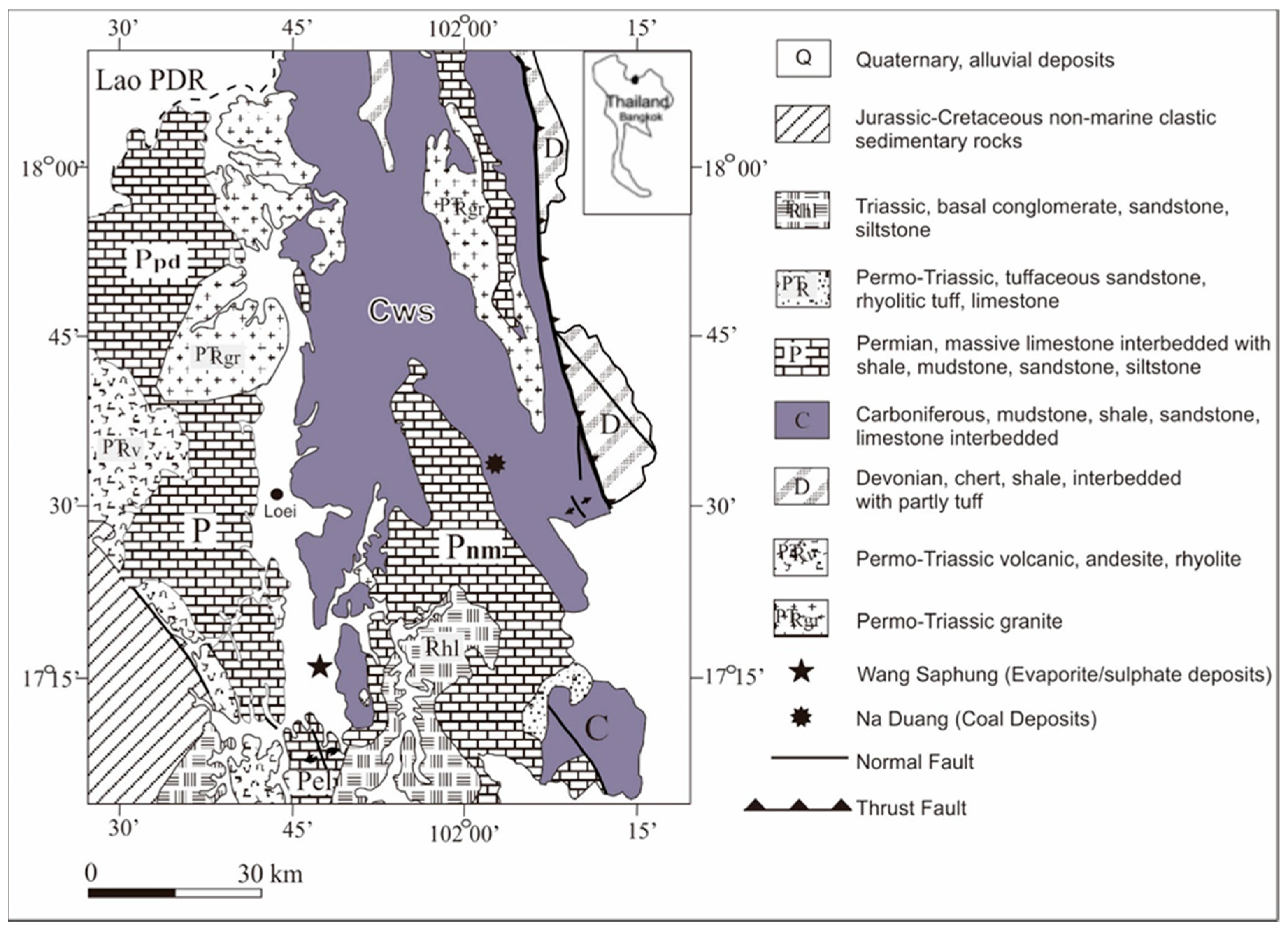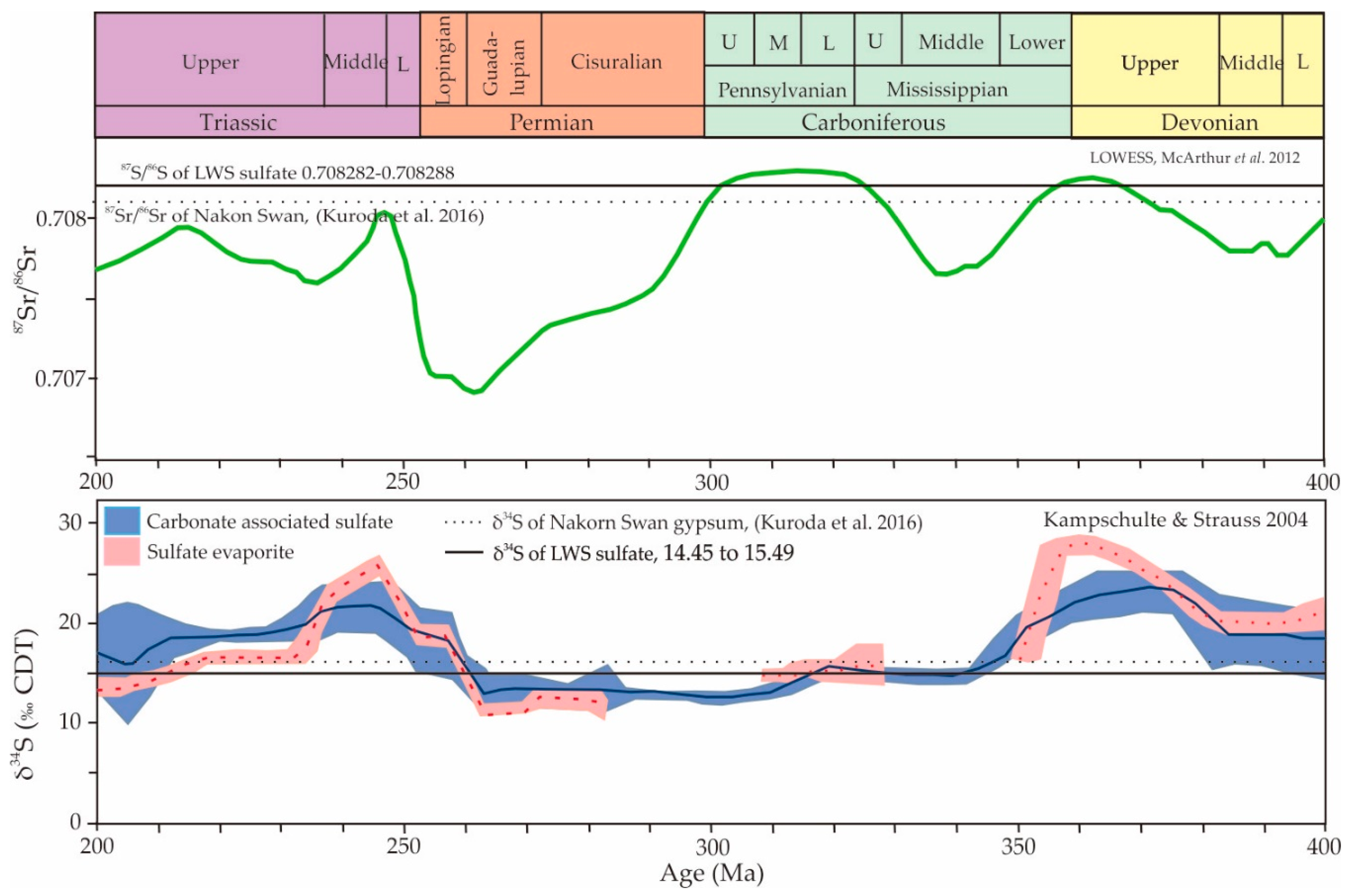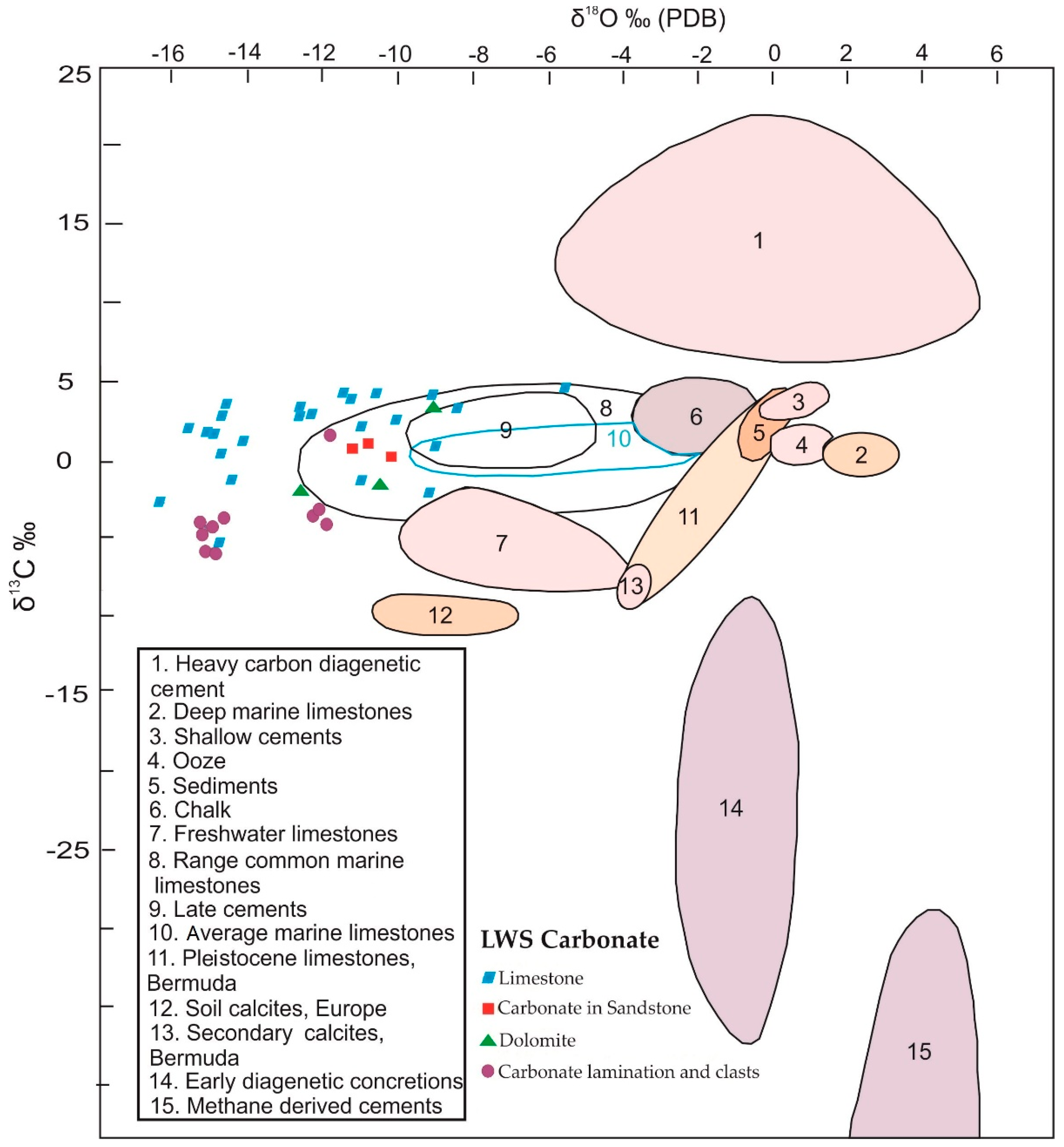Sulfur, Strontium, Carbon, and Oxygen Isotopes of Calcium Sulfate Deposits in Late Carboniferous Rocks of the Loei-Wang Saphung (LWS) Area, Loei Province, Thailand
Abstract
:1. Introduction
2. Materials and Methods
2.1. Geology of the LWS Area
2.2. Sample Collecting and Analysis
3. Results
3.1. δ34S Values
3.2. Strontium Isotope
3.3. Carbon Isotope
3.4. Oxygen Isotope
4. Discussion
5. Conclusions
- (1)
- Stable isotope data revealed that the LWS evaporite deposit was originally formed from seawater. The evidence was found in both S and Sr from the sulfate beds and C and O from the carbonate beds. Therefore, the evaporite and carbonate sequence must have been formed in the same basin during the same time.
- (2)
- The negative value of the δ18O isotopic signal was a result of meteoric alteration during subaerial exposures of the sections.
- (3)
- The δ34S values indicated an age of Late-Carboniferous and between the Late Triassic and Tertiary ages, while the Sr isotope indicated an age of Late Paleozoic during the Middle to Late Devonian and Middle to Late Carboniferous. Combined with the results of microfossils analysis from previous work [5,8], the age of these deposits is most likely the Middle to Late Carboniferous.
Author Contributions
Funding
Acknowledgments
Conflicts of Interest
References
- Kasprzyk, A. Gypsum-to-anhydrite transition in the Miocene of southern Poland. J. Sediment. Res. 1995, 65, 348–357. [Google Scholar]
- Warren, J.K. Evaporites: Sediments, Resources and Hydrocarbons, 1st ed.; Springer: Berlin, Germany, 2006; p. 1036. ISBN 978-3-540-32344-0. [Google Scholar]
- Department of Mineral Resources (DMR). Geological Map of Loei Province (1:100,000); Department of Mineral Resources: Bangkok, Thailand, 2007.
- Utha-aroon, C.; Surinkum, A. Gypsum exploration in Wang Saphung, Loei. In Proceedings of the International Conference on Geology, Geotechnology and Mineral Resources of Indochina (Geoindo 1995), Khon Kaen, Thailand, 22–25 November 1995; Youngme, W., Buaphan, C., Srisuk, K., Lertsirivorakul, R., Eds.; Department of Geotechnology, Khon Kaen University: Khon Kaen, Thailand, 1995; pp. 255–266. [Google Scholar]
- Surakotra, N.; Charusiri, P.; Promkotra, S.; Hisada, K. Petrology and alteration of calcium sulfate deposits in Late Paleozoic rocks of Wang Saphung area, Loei Province, Thailand. J. Earth Sci. Clim. Chang. 2017, 8. [Google Scholar] [CrossRef]
- Laveine, J.; Ratanasthien, B.; Sititach, S. The Carboniferous flora of Northeastern Thailand. Rev. Palaeobiol. Geneve 2003, 22, 761–797. [Google Scholar]
- Laveine, J.; Ratanasthien, B.; Sititach, S. The Carboniferous flora of northeastern Thailand: Additional documentation from the Na Duang—Na Klang basin. Rev. Paléobiol. Genève 2009, 28, 315–331. [Google Scholar]
- Fontaine, H.; Salyapongse, S.; Utha-aroon, C.; Vachard, D. Age of limestones associated with gypsum deposits in northeast and central Thailand, A first report. CCOP Newslett. 1997, 21, 6–10. [Google Scholar]
- Holser, W.T. Catastrophic chemical events in the history of the ocean. Nature 1977, 267, 403–408. [Google Scholar] [CrossRef]
- Claypool, G.E.; Holser, W.T.; Kaplan, I.R.; Sakai, H.; Zak, I. The age curves of sulfur and oxygen isotopes in marine sulfate and their mutual interpretation. Chem. Geol. 1980, 28, 199–260. [Google Scholar] [CrossRef]
- Burke, W.H.; Denison, R.E.; Hetherington, E.A.; Koepnick, R.B.; Nelson, H.F.; Otto, J.B. Variation of seawater 87Sr/86Sr throughout Phanerozoic time. Geology 1982, 10, 516–519. [Google Scholar] [CrossRef]
- Grinenko, V.A.; Krouse, H.R.; Nikanorov, A.M. Use of hydrochemical and isotopic criteria for the evaluation of the influence of technogenic sulfur on surface waters. In Proceedings of the Isotope Techniques in Water Resources Development, IAEA, Vienna, Austria, 11–15 March 1992; pp. 477–494. [Google Scholar]
- Palmer, M.R.; Edmond, J.M. The Strontium Isotope Budget of the Modern Ocean. Earth Planet. Sci. Lett. 1989, 92, 11–26. [Google Scholar] [CrossRef]
- Cooper, M.; Herberrt, R.; Hill, G. The structural evolution of Triassic intermontane basins in northeastern Thailand. In Proceedings of the International Symposium on Intermontane Basins: Geology & Resources, Chiang Mai, Thailand, 30 January–2 February 1989; pp. 231–242. [Google Scholar]
- Mitchell, A. Mesozoic and Cenozoic regional tectonics and metallogenesis in mainland SE Asia. In Proceedings of the GEOSEA V, Lumpur, Malaysia, 9–13 April 1984; Geological Society of Malaysia Bulletin 20. Geological Society of Malaysia: Wilayah Persekutuan, Malaysia, 1986; pp. 221–239. [Google Scholar]
- Metcalfe, I. Origin and assembly of south-east Asian continental terrenes. In Gondwana and Tethys; Audley-Charles, M.G., Hallam, A., Eds.; Geological Society: London, UK, 1988; pp. 101–118. [Google Scholar]
- Chairangsri, C.; Hinze, C.; Machareonsap, S.; Nakornsri, N.; Silpalit, M.; Sinpool-Anunt, S. Geological Map of Thailand 1:50,000 Exploration for Sheet Amphoe Pak Chom 5345 I, Ban Na Kho 5344 I, Ban Huai Khob 5445 IV and King Amphoe Nam Somm 5444 V; Geol. Ib. B73: Hanover, Germany, 1990; p. 109. [Google Scholar]
- Maruoka, T.; Koeberl, C.; Hancox, P.J.; Reimold, W.U. Sulfur geochemistry across a terrestrial Permian-Triassic boundary section in the Karoo Basin, South Africa. Earth Planet. Sci. Lett. 2003, 206, 101–117. [Google Scholar] [CrossRef]
- Roveri, M.; Lugli, S.; Manzi, V.; Gennaria, R.; Schreiber, B.C. High-resolution strontium isotope stratigraphy of the Messinian deep Mediterranean basins: Implications for marginal to central basins correlation. Mar. Geol. 2014, 349, 113–125. [Google Scholar] [CrossRef]
- Takahashi, T.; Hirahara, Y.; Miyazaki, T.; Vaglarov, B.S.; Chang, Q.; Kimura, J.-I.; Tatsumi, Y. Precise determination of Sr isotope ratios in igneous rock samples and application to micro-analysis of plagioclase phenocrysts. JAMSTEC Rep. Res. Dev. 2009, 2009, 59–64. [Google Scholar] [CrossRef]
- Kuroda, J.; Hara, H.; Ueno, K.; Charoentitirat, T.; Maruoka, T.; Miyazaki, T.; Miyahigashi, A.; Lugli, S. Characterization of sulfate mineral deposits in central Thailand. Island Arc 2017, 26. [Google Scholar] [CrossRef]
- McArthur, J.M.; Howarth, R.J.; Shields, G.A. Strontium isotope stratigraphy. In The Geologic Timescale 2012, 1st ed.; Gradstain, F.M., Ogg, J.G., Schmitz, M.D., Ogg, G.M., Eds.; Elsevier: New York, NY, USA, 2012; pp. 127–144. ISBN 9780444594259. [Google Scholar]
- Kampschulte, A.; Strauss, H. The sulfur isotopic evolution of Phanerozoic seawater based on the analysis of structurally substituted sulfate in carbonates. Chem. Geol. 2004, 204, 255–286. [Google Scholar] [CrossRef]
- Hudson, J.D. Stable isotopes and limestone lithification. J. Geol. Soc. 1977, 133, 637–660. [Google Scholar] [CrossRef]
- Worden, R.H.; Smalley, P.C.; Fallick, A.E. Sulfur cycle in buried evaporates. Geology 1997, 25, 643–646. [Google Scholar] [CrossRef]
- Paytan, A.; Kastner, M.; Campbell, D.; Thiemens, M.H. Sulfur isotopic composition of Cenozoic seawater sulfate. Science 1998, 282, 1459–1462. [Google Scholar] [CrossRef] [PubMed]
- Lazar, B.; Erez, J. Carbon geochemistry of marine-derived brines: I. 13C depletions due to intense photosynthesis. Geochim. Cosmochim. Acta 1992, 56, 335–345. [Google Scholar] [CrossRef]
- Dickson, J.A.D.; Coleman, M.L. Changes in Carbon and Oxygen Isotope Composition during Limestone Diagenesis. In Carbonate Diagenesis; Tucker, M.E., Bathurst, R.G.C., Eds.; Blackwell Scientific Publications: London, UK, 2009; pp. 259–270. ISBN 978-1-444-30452-7. [Google Scholar]
- Allan, J.R.L.; Matthews, R.K. Isotopic signatures associated with early meteoric diagenesis. Sedimentology 1982, 29, 797–817. [Google Scholar] [CrossRef]
- James, N.P.; Choquette, P.W. Limestones—The sea floor diagenetic environment. In Diagenesis; Mcllreath, I.A., Morrow, D.W., Eds.; Geoscience Canada Reprint Series No.4; Geoscience Canada: Burnaby, BC, Canada, 1990; pp. 75–112. [Google Scholar]
- Marshall, J.D. Climatic and oceanographic isotopic signals from the carbonate rock record and their preservation. Geol. Mag. 1992, 129, 143–160. [Google Scholar] [CrossRef]
- Decima, A.; McKenzie, J.A.; Schreiber, B.C. The origin of evaporative limestones: An example from the Messinian of Sicily (Italy). J. Sed. Petrol. 1988, 58, 256–272. [Google Scholar] [CrossRef]
- Bottrell, S.H.; Newton, R.J. Reconstruction of changes in global sulfur cycling from marine sulfate isotope. Earth Sci. Rev. 2006, 75, 59–83. [Google Scholar] [CrossRef]



| Sample | Drill Hole No. | Depth (m) | δ34Scalc (‰) | 87Sr/86S | Comments |
|---|---|---|---|---|---|
| NS-1-anh | WP03 | 73.0 | 14.1 | Near volcanic contact | |
| NS-2-anh | WP03 | 79.5 | 14.0 | 0.708288 | Dense anhydrite |
| NS-4-anh | WP10 | 23.5 | 14.4 | Dense anhydrite | |
| NS-6-anh | WP28 | 64.5 | 14.6 | Dense anhydrite | |
| Average | 14.3 | ||||
| SD | 00.3 | ||||
| NS-3-gyp | WP04 | 27.0 | 15.0 | 0.708282 | Alabastrine gypsum |
| NS-5-gyp | WP20 | 67.3 | 15.5 | Selenite gypsum | |
| NS-7-gyp | WP29 | 32.0 | 14.5 | Alabastrine gypsum | |
| NS-9-gyp | WP30 | 36.8 | 14.6 | Alabastrine gypsum | |
| NS-10-gyp | WP30 | 52.5 | 15.3 | Alabastrine gypsum | |
| Average | 15.0 | ||||
| SD | 00.4 |
| Sample | Drill Hole No. | Depth (m) | 13C | 18OPDB | Comments |
|---|---|---|---|---|---|
| AA1 | WP2 | 54.26 | 4.1 | −11.4 | Micrite |
| AA1 | WP2 | 54.26 | 4.3 | −11.8 | Duplicate run |
| AA2 | WP2 | 54.26 | 4.4 | −9.1 | Crystalline (grainier) |
| AA21 | WP2 | 41.20 | 4.5 | −11.6 | Limestone |
| AA54 | WP3a | 47.00 | 1.9 | −15.3 | Micritic limestone |
| AA56 | WP3a | 40.30 | 1.8 | −15.2 | Micrite limestone |
| AA55 | WP3b | 47.00 | 2.2 | −15.9 | Fractured coconut calcite |
| N2 | WP4 | 16.60 | 1.0 | −9.1 | Calcite (recrystallized) |
| AA17 | WP6a | 18.30 | 0.5 | −15.0 | Limestone |
| AA5 | WP7b | 38.00 | 4.5 | −10.7 | Crystalline (grainier) |
| N5 | WP9 | 40.00 | 2.3 | −11.1 | Fossil |
| AA35 | WP9a | 48.00 | 3.0 | −14.9 | Grey limestone |
| AA36 | WP9b | 48.00 | 1.3 | −14.3 | Late-stage white vein fill carbonate |
| N6 | WP12 | 36.50 | –5.4 | −15.0 | Sparite |
| N7 | WP12 | 36.50 | –2.7 | −16.6 | Calcite vein |
| AA32 | WP13c | 37.20 | 4.8 | −5.5 | Crackle breccia matrix |
| AA40 | WP15 | 11.00 | –1.3 | −11.1 | Limestone |
| N8 | WP16 | 16.60 | 1.2 | −10.9 | Carbonate within sandstone |
| N9 | WP16 | 16.60 | 0.3 | −10.3 | Carbonate within sandstone |
| AA27 | WP17b | 39.50 | 3.7 | −8.5 | Crystalline grainy limestone |
| AA29 | WP17b | 23.70 | 2.7 | −10.1 | Crystalline (grainier) |
| AA24 | WP23a | 82.30 | 3.1 | −12.5 | Limestone |
| N10 | WP30 | 32.00 | 3.5 | −12.8 | Calcite (grind) |
| N12 | WP30 | 32.00 | 3.0 | −12.8 | Calcite (recrystallized) |
| N17 | WP30 | 39.70 | –3.5 | −12.4 | Recrystallized carbonate |
| N1 | WP4 | 16.6 | –1.5 | −9.1 | Dolomite replaced by Fe-oxide material |
| AA26 | WP17a | 39.50 | –1.9 | −10.6 | Buff dolomite clast |
| N11 | WP30 | 32.00 | 3.5 | −12.8 | Dolomite |
| N3 | WP4 | 16.60 | –2.1 | −9.2 | Dark mineral on fracture |
| N13 | WP30 | 39.70 | –3.6 | −12.8 | Pyritic |
| AA4 | WP7a | 38.00 | 3.8 | −14.8 | Micrite |
| AA28 | WP17a | 23.70 | 1.9 | −12.0 | Micrite clast |
| AA49 | WP30 | 36.80 | –1.3 | −14.7 | Micrite clast |
| N14 | WP30 | 39.70 | –4.1 | −12.1 | Micrite lamina |
| N15 | WP30 | 39.70 | –3.0 | −12.2 | Micrite |
| AA11 | WP30a | 54.00 | –4.6 | −15.4 | Micrite clast |
| AA47 | WP30a | 39.70 | –3.8 | −14.9 | Micrite rim |
| AA13 | WP30b | 40.00 | –4.0 | −15.5 | Micrite (radial textured) |
| AA15 | WP30b | 32.70 | –4.3 | −15.3 | Micrite (unreplaced) |
| AA45 | WP30b | 60.50 | –5.8 | −15.2 | Altered buff-green rim |
| AA46 | WP30c | 60.50 | –5.8 | −15.34 | Light flow-contorted |
| Maximum | 4.8 | −5.5 | |||
| Minimum | –5.8 | −16.6 | |||
| Average | –1.0 | −12.5 |
© 2018 by the authors. Licensee MDPI, Basel, Switzerland. This article is an open access article distributed under the terms and conditions of the Creative Commons Attribution (CC BY) license (http://creativecommons.org/licenses/by/4.0/).
Share and Cite
Surakotra, N.; Promkotra, S.; Charusiri, P.; Maruoka, T.; Hisada, K.-i. Sulfur, Strontium, Carbon, and Oxygen Isotopes of Calcium Sulfate Deposits in Late Carboniferous Rocks of the Loei-Wang Saphung (LWS) Area, Loei Province, Thailand. Geosciences 2018, 8, 229. https://doi.org/10.3390/geosciences8070229
Surakotra N, Promkotra S, Charusiri P, Maruoka T, Hisada K-i. Sulfur, Strontium, Carbon, and Oxygen Isotopes of Calcium Sulfate Deposits in Late Carboniferous Rocks of the Loei-Wang Saphung (LWS) Area, Loei Province, Thailand. Geosciences. 2018; 8(7):229. https://doi.org/10.3390/geosciences8070229
Chicago/Turabian StyleSurakotra, Nusara, Sarunya Promkotra, Punya Charusiri, Teruyuki Maruoka, and Ken-inchiro Hisada. 2018. "Sulfur, Strontium, Carbon, and Oxygen Isotopes of Calcium Sulfate Deposits in Late Carboniferous Rocks of the Loei-Wang Saphung (LWS) Area, Loei Province, Thailand" Geosciences 8, no. 7: 229. https://doi.org/10.3390/geosciences8070229
APA StyleSurakotra, N., Promkotra, S., Charusiri, P., Maruoka, T., & Hisada, K.-i. (2018). Sulfur, Strontium, Carbon, and Oxygen Isotopes of Calcium Sulfate Deposits in Late Carboniferous Rocks of the Loei-Wang Saphung (LWS) Area, Loei Province, Thailand. Geosciences, 8(7), 229. https://doi.org/10.3390/geosciences8070229




